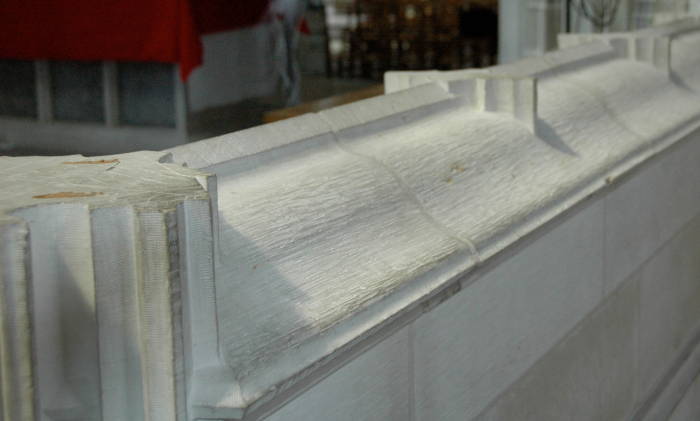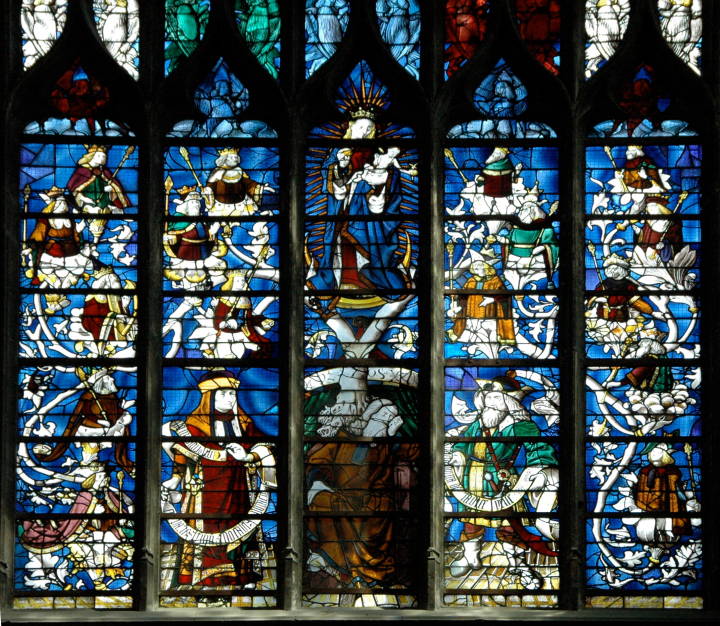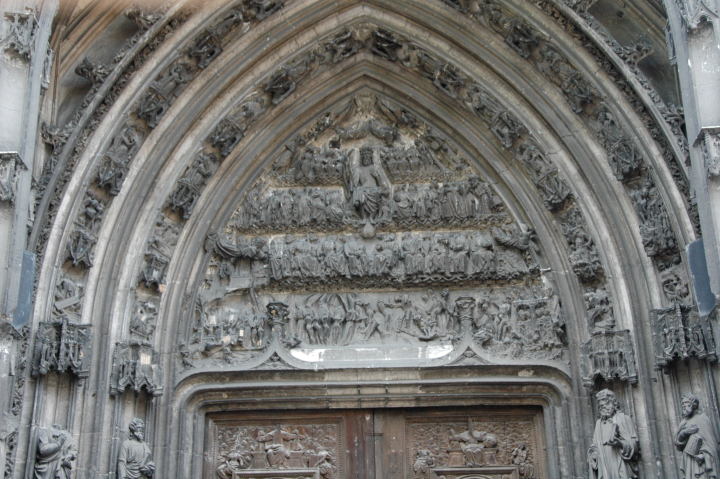St. Maclou




Everyone wanted to see the inside of this church about which Ruskin had written so much, but it is usually locked. Paul André, who knew the person in the art school who had a key, obtained it and let us inside, where he explained why the church beautifully exemplifies the finest Perpendicular Gothic — “perpendicular,” George learned, because it has no capitals at the top of the columns and piers, and thus looks especially elegant. He also pointed out which sections destroyed by RAF bombing — Rouen is in Normandy — had finally been restored. Left: Looking down the right aisle. Middle left: One of the massive piers. Middle right: the beautiful joining of the arches. Right: the nave ceiling.



Left: Another view of the right isle. Middle: A partial restoration awaiting the pillars that will surmount this section. Looking around the church, one catches sight of cubic blocks protruding from some of the pillars, which are awaiting their sculptors (and the money to pay them). Right: Looking up to the lantern, which had been closed in for some reason until recently. Now that they have been restored to their original form, the church, which had been dark and gloomy, now feels wonderfully light and airy.



More pictures of various kinds of stone carving, some of which Ruskin drew for The Seven Lamps of Architecture.




Left: George photographed this bit of gothic tracery because Ruskin had several examples of it in The Seven Lamps, and he wasn't sure if this might have been one of the originals. Middle left: A beautiful fifteenth- or sixteenth-century stained glass Jesse tree showing Christ's descent from King David. Middle right: The significance of this pier lies in the fact that it replaces the usual chapel that almost all gothic churches place directly behind the altar. As Ruskin pointed out, gothic was a functional architecture, and apparently the architects believed they needed that pier to keep the building from falling down, so they put it there instead of a chapel. Right: The famous carving above the doorway, which Ruskin had photographed.
The Ossuary


After St. Maclou, Paul André took us to what had been the old cemetery surrounded by buildings that held the bones of the dead, which were dug up, according to medieval and later custom, once th bodies decomposed. Note in the middle photo the skulls an shovels. (We also have a photo of a coffin carved farther to the right.) The party leaves the ossuary, which now houses an art school.

The Building on Rue du Ruissel



Heading toward a fountain that Ruskin had drawn, we paused at this building, which has one restored carving and another needing it.
Rue de l'eau Robec and the Fountain of Saint-Pierre




Left: Turning right from the Rue du Ruissel, we entered the Rue de l'eau Robec named after the little stream, which now runs along the side. Sometime (in the twentieth century?) the city covered over the river, but when tourists complained they created this picturesque little simulacrum as a replacement. No authenticity here! Middle Looking back at the group from the head of Rue de l'eau Robec. George took this photo for the overhanging roof of the old building. Right two: Since Diane Leonard, who had joined the group at lunch, moved slowly with her walker, George and Cynthia went on alone to see the Fountain of Saint-Pierre, about which she had written. It sits in the middle of a residential, distinctly non-picturesque district.
Unable to find the rest of the group, who, it later turned out, had taken a different route, George and Cynthia decamped to their various hotels, rested, and waited for dinner. Twenty years before Diane and her son Kevin had stayed in a hotel near the train station and had one of the great meals of their lives — pressed duck. Hearing this, Jim insisted that she make reservations for all of us at the very pricey restaurant. Diane and several others took a cab while Jim, Roger, Cynthia, and George walked on a lovely cool evening.
The Presssed Duck and the be-medallioned duck-carcasse squeezer
At the lovely restaurant, which the same family has owned for 5 generations, we learned about how they make their famous pressed duck: After roasting and deboning the duck, the master of ducks (his French title is actually something like this) puts the bones, gizzards, and the rest of the duck remains into a special metal press and turns the screw until blood (ugh) flows out, which is then saved and made the basis of the special sauce, or at least that's what the young man said, although since the chef in the kitchen has already made a bordelaise sauce to which the Duck-squeezing person at the table adds (a) Brandy, (b) Calbados, (c) red wine, and (d) some other alcohol, plus (like MacDonald's) the usual blend of secret spices. Cynthia, who declared she had suddenly become a vegetarian for the duration of this meal, and George, who didn't want to spend the money, had other very nice dishes, but when we had a tiny taste of the sauce (neither could resist) it seemed to taste heavily of cloves. Anyway, Kevin thought the taste intense but as good as he recalled whereas his mom, Diane, didn't seem to like it all that much. And in succeeding days, she said that it hadn't lived up to her remembrance.
More about On the Old Road V — June 2010
- The Master of the Old Road sends an e-mail invitation
- George arrives in Rouen and finds himself in the Twilight Zone
- George meets up with the Ruskinians
- Lunch near St. Maclou
- Reading Ruskin in the presence of the work he describes
- Paul André Sement gets us into St. Maclou
- The Ossuary or Boneyard
- From Rouen to Caen with a stop at Lisieux
- With The Ruskinians in Caen — St. Peter's Church. William the Conqueror's castle, men wearing lipstick, and other grotesques
- With The Ruskinians in St. Lô, Coutances, and Bayeux — a long day
- The first two days in Chartres
- The last morning in Chartres
Last modified 5 July 2010
